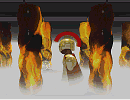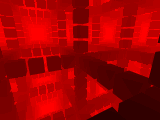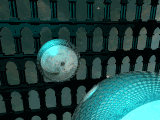Hinc Itur Ad Astra [Latin] - From Here The Way Leads To The Stars
The old world was obsolete. We could neither tame nor slay the dragon of corruption, but only starve it by dismantling its incentives. - Dietrich Lehrer, Lyceum Archives
Rewire the system, don’t burn it down.
In Galesburg, Illinois—a city in Knox County, 45 miles northwest of Peoria, where the Railroad Days festival once drew crowds to celebrate its iron veins—Dietrich Lehrer grew up on a sprawling estate, surrounded not by kin but by the hum of robots he called companions. Born into the Lehrer/Sheen empire, its roots tracing to Elias Lehrer’s 1895 adoption by Charles Sheen via the Orphan Trains, Dietrich was no heir to luxury. He was a solitary figure who saw the world through a peculiar lens, where the love of money, not its absence, wove corruption through science, faith, and human potential. By 2075, as CEO of Lehrer/Sheen, Dietrich became the reluctant fulcrum of the Global Revolution, steering a world on the brink of violence toward the fragile dawn of New Pangea from the Laurasia space station’s quiet decks.
Dietrich’s vision of New Pangea was not a utopia of gleaming towers but a mindset—a global village where currency, debt, politics, and borders dissolved, letting cultures thrive without control. He shunned crusades; neither religion nor politics stirred his atheistic soul. Humanity’s flaws, he believed, were a machine in need of rewiring, not a beast to be fought. Progress faltered when greed twisted purpose, and the solution lay in starving corruption’s incentives. The Lehrer/Sheen empire, built from Elias’s mercantile beginnings, gave him the tools to act. Robots, to Dietrich, were liberators, freeing humanity from labor to pursue meaning—whether in a community hub where goods flowed freely, a learning circle tailored to each mind, or a quiet moment of reflection.
The Global Revolution, a storm of rage and hope, erupted from centuries of inequality. Some demanded wealth redistribution, tearing down the old order with fire. Dietrich, poring over his grandfather’s library of Turnvereine journals and dusty books on the Galesburg estate, learned from the internet’s archives and his family’s revolutionary roots that power given to the vengeful bred tyrants. Rewire the system, he urged, his voice steady but unyielding. His peers called it quixotic, but his pragmatism was rooted in a truth gleaned from Galesburg’s fading railroads: money was a tool, not an end, and its love was the root of evil. From Laurasia, he guided Lehrer/Sheen’s resources to turn this vision into reality, avoiding the chaos of violence for a subtler path.
Lehrer/Sheen’s wealth and robotics fueled this shift through the Ministry of Science and Technology (MOST), a network of algorithms and androids that dismantled money, debt, and politics. MOST wasn’t a government but a system ensuring resources—food, medicine, tools—reached all without cost. In New Pangea’s global village, a grower sharing seeds or a guide mentoring minds connected freely, unhindered by borders. Lehrer/Sheen’s maglev trains glided across continents, robots tended fields, and learning circles fostered lifelong growth, not state-driven dogma. Some clung to old ways—hoarding worthless money or working as hobbies—but MOST’s human-AI connectors, volunteers driven by curiosity, bridged the transition. Dietrich’s vision, born in Galesburg’s quiet, became a world where daily life flowed like its railroads—steady, unassuming, vital.
His influence was subtle, not theatrical. From Laurasia’s labs, Dietrich met with scientists and social engineers via holographic calls, sketching solutions on an electronic tablet—a precursor to the Lyceum. His plans mapped resource flows, not battle lines, calming riots with robot-delivered supplies. The revolution turned peaceful, not by force but by design. The Galesburg estate, now a museum of Lehrer/Sheen’s legacy, stood empty as Dietrich, with his grandson Christian Lehrer and Laurasia’s first captain, Akio Tsukino, oversaw MOST’s rollout. Laurasia, built by Lehrer/Sheen, was no mere outpost but a hub for innovation, its six-month captaincies rotating through figures like Akio, Dietrich, Kacela Adesina, and Christian, though their order remains uncertain in the archives.
Dietrich’s isolation shaped this vision. On the Galesburg estate, he had no siblings, only absent parents and robots. As a boy, he rode a Lehrer/Sheen hoverboard across the grounds, the factory a mile away where he tinkered with circuits. His closest human contact was Akio, a young caretaker hired to drive him to the factory in a sleek transport. Akio’s quiet presence taught Dietrich to value human-AI synergy, a cornerstone of MOST. In the factory, he lost himself in robotics, their circuits free of greed or judgment. The estate’s library, filled with his grandfather’s journals, fueled his fascination with history, not as nostalgia but as a warning: tools like money shaped wars and walls, not truths.
Laurasia became Dietrich’s home during the revolution, its labs birthing MOST’s algorithms. He died there, around age 60, early in the revolution’s dawn. An atheist to the end, he chose a space burial—his body cast into the void, no resurrection hoped for, only eternal nothing. His death, like his life, was detached, his hope in the system he’d built, not in earthly or celestial promises. The Galesburg estate, preserved as a museum, and Laurasia, now MOST’s hub alongside Verdant Rim’s Quiet Zone, carried his legacy.
New Pangea, for all its promise, was not eternal. By the time of Verdant Rim, when a Lehrer girl sifted through the rubble of a world undone—perhaps by schemes or calamity—Dietrich’s global village was a memory. The Lyceum, a tablet-like device used by Laurasia’s passengers to connect with Earth, preserved his vision. Linked to MOST’s archives, it held Christian’s chronicles and Raymond Sheen’s data, the android/part-human Dietrich inspired to record history. Raymond, created to be a living archive, ensured the Lehrer girl found the Lyceum, its data a guide through the ruins. Dietrich’s legacy, etched in MOST’s algorithms and Raymond’s quest, endures not as a solution but as a record, preserved by machines for those who seek beyond.









